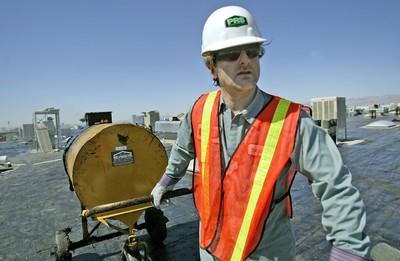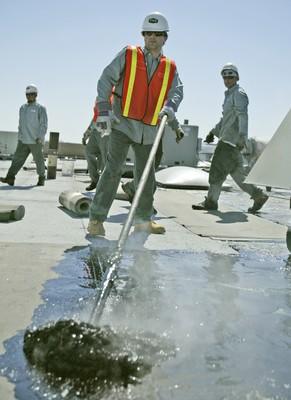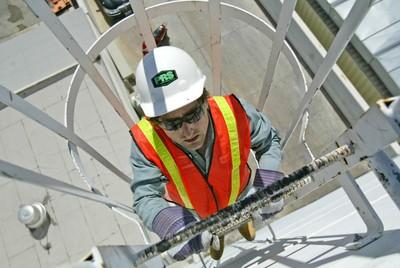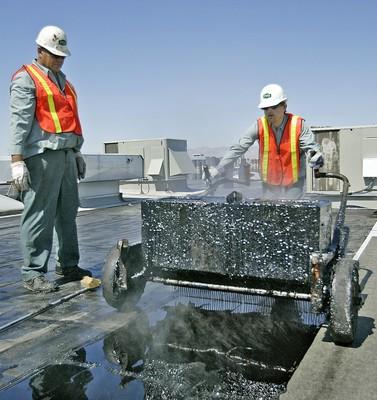FEELING THE BURN – Hotfoot (Roofer)





"Pull it!" Eddy Jefferson yells. "Pull it towards you!"
The roof isn’t on fire. But something is definitely amiss atop the CPI Card Group building. As a roof installer, it is my job to flip over a 3-foot roll of vinyl carpet, called a cap sheet, onto a patch of freshly laid tar.
My flip flops, however, because the cap sheet refuses to land where my arms tell it to. And the adhesion of the hot tar has doubled its 100-pound weight.
"Quicker!" Jefferson continues.
I argued hard for this responsibility. Flipping a cap sheet is the most precise job on a hot-tar crew. But Jefferson and his co-workers at Professional Roofing Services resisted for two hours. This is a six-figure contract, and they already are behind two days because of high winds. No less than 400 10-square-feet patches need to be laid today.
"This is big-man stuff, Carlos!" Jefferson told me.
Carlos is the name on my uniform — the only one of 87 in the company that fits. But the guy it belongs to wouldn’t be allowed anywhere near a hot-tar crew.
"Carlos looks like he’s 8 years old," says PRS safety director Patrick Young. "He’s about 4 feet tall. A good strong wind and he’s gone."
Carlos nails tile into slanted roofs. For that job, being small is a plus because the tiles he walks across, and the ropes he hangs from, are less likely to break.
I’m on a flat roof, however, where every single task seems to require schlepping some anvil-heavy object some remote distance from wherever it is. The prison-style hard labor began at 5:30 a.m. and the sun feels every one of the five floors it is closer to the top of my head.
"There ain’t no getting used to the heat," Jefferson says.
It’s not that I thought hot-tar roofing would be fun. I just didn’t realize that complete and utter drudgery would be the high point of my day.
"Basically, yeah, this job sucks," Young said earlier. "Nobody wants to be a roofer — especially a hot roofer. There’s a high turnover rate. It’s really hard to keep a good, solid crew."
Jefferson, 27, requested a transfer off hot crew last year, because he says that tearing roofs off old buildings provides steadier work. (Occasionally, he fills in when extra hot-crew workers are needed, as they are today.)
"The thing I like about roofing, I guess, is the money," says the Clark High School graduate, who has a wife and four kids to support. (Roofers earn $9 to $26 an hour.)
"I wanted to go to the NFL when I was younger, but it just didn’t happen," he says. "I tried, though."
Jefferson attended San Bernardino Valley College for a year and a half, running plays for the Indians. After dropping out, his cousin got him a job driving a truck for a roofing company in the mid-90s, from which he worked his way up.
"Andele!" foreman Effrain Velarde yells at me.
Apparently, approaching a kettle of 500-degree tar is something one can do too slowly. Perhaps I’d move quicker if the air available for breathing in its vicinity weren’t threatening to cause my nostril hairs to burst into flames.
This is my first job of the day. It’s at ground level, and it’s called kettleman. (In the summer, to prevent heat exhaustion, hot-tar crew members routinely rotate positions.) Kettlemen ax keg-sized cylinders of solid asphalt in half — usually in one-sixth of the six swings it takes me per keg — so the pieces can fit manageably into the cauldron of smelly, boiling blackness.
I dunk my first piece, as gently as Arnold Schwarzenegger lowered himself into oblivion at the end of "Terminator 2."
Suddenly, it buoys back up, and I scurry away like a schoolgirl.
"Sometimes it’ll splash out on the guys and they’ll burn their chest and face area," Young said earlier. "We’ve been pretty fortunate that we haven’t had any severe accidents."
Now is a good time to point out that roofers are six times more likely to die on the job than average full-time American employees, according to a 2003 University of Florida study. (More than 21 per 100,000 perish each year.)
"And hot tar is definitely the most hazardous kind of roof work there is," Young said.
"Pull that rope, Carlos!" Jefferson yells.
Now I’m a bucket man. After a 100-foot climb to the roof — straight up a swimming pool ladder with no safety harness or net — I’m ordered to jerk on a rope attached to the kettle. This is supposed to open a valve that forces tar up through temporary steel piping and into the miniature oil drum beside me.
Of course, it doesn’t. So I shift positions to get better leverage — four times. Like a Lilliputian trying to tie up Gulliver all by himself, I require immediate assistance.
"This is all you gotta do, Carlos!" Jefferson says after tugging the rope with barely more than a wrist flick. Tar floods the drum as he cackles.
Normally, I slow businesses down enough for my subjects to want me off the job after a couple of hours. But these roofers want me around all day. To them, I’m as funny as Carrot Top (although a lot less useful, because Carrot Top is buff and could probably cause most of the objects up here to budge).
"No muscles!" yells another worker, who doubles over in laughter when I try moving a 50-pound mop drenched with tar. (And mopping is not one of my strong suits to begin with. Ask my fiancee.)
All fun ends at the cap sheet, however.
"Step aside!" Jefferson shouts as he yanks my misflip off the tar. He grimaces at the squishing sound that accompanies this motion. Strings of tar mozzarella shoot out in all directions.
"See what you just did?" Young asks me.
Strings, formed when tar cools, are a no-no. As the sun heats them up, they deteriorate the surface underneath, setting the stage for future leaks.
"Now, we’re going to have to come back with a hot torch later and heat that area up," Young says, shaking his head.
"You just created a lot more work."
Fortunately for me, there are no feathers up here.
Watch video of Levitan as a roofer at www.reviewjournal.com/video/fearandloafing.html. Fear and Loafing runs Mondays in the Living section. Levitan’s previous adventures are posted at fearandloafing.com.
COREY LEVITANFEAR AND LOAFINGWatch Video












